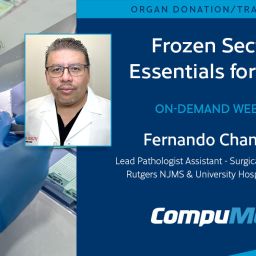
In Part One of our two-part blog series on Frozen Section Essentials, we’ll walk you through some general considerations for an OPO lab that can help you achieve a streamlined and effective biopsy process for preparing high-quality frozen section slides.
By establishing an in-house lab for donor-organ frozen sections, OPOs, especially those with existing donor care units (DCUs), can reduce wait times, improve the accuracy of organ evaluations, be more efficient, and ultimately save more lives through donation and transplantation.
But what does it take to set up a lab and produce the high-quality frozen sections necessary for timely diagnostic procedures and accurate interpretations?
Consider this your starting checklist to position your team for success, and please feel free to contact us for more comprehensive information and budget guidance.
OPO Lab Checklist: The Basics
Ventilation
One of the initial considerations for your lab is ensuring proper ventilation, which is essential when dealing with certain chemicals and substances. For example, if you work with saline or formalin, specialized hoods and filters that are approved for these substances are necessary. Proper ventilation not only protects your team from harmful fumes but also maintains a clean environment, crucial for accurate and safe organ tissue processing.
Illumination
Good lighting is key to a streamlined and effective biopsy process. Proper illumination is crucial for accurately visualizing organ tissue details during frozen sectioning.
Water Source
A sink is an essential component of any lab, providing a convenient location for washing equipment and cleaning tools. It also supplies stop water for solutions and helps with the quick cleaning of hands or surfaces, which is important for maintaining hygiene and minimizing the risk of contamination during the delicate process of preparing frozen sections.
Refrigerator
A dedicated refrigerator is vital in a frozen section lab to store and pre-chill materials such as OCT compound, a liquid embedding medium that surrounds and helps freeze tissue samples before sectioning.
When used alongside a cryostat, which we’ll cover in Part Two of our blog series, a refrigerator helps enable fast and accurate tissue preparation. This helps reduce the risk of artifact and maintain good quality samples for accurate interpretation.
Proper Disposal of Biohazard Material and Sharps
Proper disposal of biohazard material is critical in a lab setting. Potentially contaminated tissue comes into an OPO lab in the form of fresh tissue and requires careful handling and disposal according to regulatory standards. Ensuring compliance with OSHA regulations (always check with your local, state and federal regulations) for biohazard disposal is vital for maintaining a safe lab environment and protecting the health of your OPO team members.
It is also important to properly dispose of all sharps or blades used in the lab. Designated sharps disposal containers can help avoid potential contamination of other lab materials and prevent accidental injuries.
Cleaning and Disinfecting Agents
When working with equipment set at -23 degrees, the presence of water means there is a high probability of ice crystals forming. Therefore, selecting appropriate cleaning and disinfecting agents is crucial. Choose mycobactericidal or tuberculocidal disinfectants that effectively clean without leaving behind water, ensuring that your equipment remains in the best condition possible for accurate organ tissue processing.
Necessary Supplies
Stocking your lab with the necessary consumables is essential for maintaining smooth operations. This includes items like blades and other disposable tools regularly used in the donor-organ frozen section process. Ensuring you have an adequate supply of these materials will help prevent disruptions and ensure your lab can function efficiently.
Next Steps
Now that you’ve covered these initial considerations for setting up your lab, it’s time to examine the specific tools and equipment needed for donor-organ frozen sections. Check out Part Two of our blog series on Frozen Section Essentials to learn more about the features and advantages of certain lab tools and equipment.
More Frozen Section Resources for You
Slide Savvy with Fernando: Check out our webinar series for tips on how to troubleshoot issues that occur during frozen sectioning, as shared by Fernando Chang, IMG, a renowned pathologist assistant specializing in frozen section analysis.
Consultations and Feedback: CompuMed’s lead pathologist assistant is available to provide clients with consultations, training and feedback on samples. Contact us to learn more.
CompuMed’s Remote Pathology Services: We also offer digital pathology reads and interpretations. See why our biopsy reports are known for being timely and consistent and how they give transplant centers the confidence to say yes to an organ faster.











